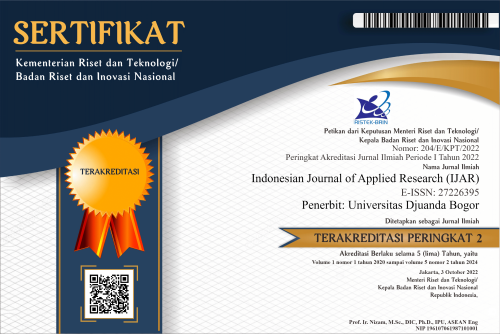Durian Peel Waste as An Alternative Material for Oxalic Acid Using The Nitric Acid Oxidation Method
Abstract
Durian (Durio zibethinus murr) was a tropical fruit from Southeast Asia. Based on the content, the durian peel waste has the potential to be used as a raw material in the process of making oxalic acid. The cellulose content found in durian peel is 50-60%, and there was lignin and starch content of 5% for each. Oxalic acid is an organic compound with the formula C2H2O4. This study aimed to determine the effect of nitric acid concentration and oxidation time of durian peel on yield, oxalic acid content, and the quality of the oxalic acid produced. The method used in this study was the oxidation process. The influential variables in the oxidation process with nitric acid were the concentration and heating time. The higher the nitric acid concentration, the greater the % yield of oxalic acid produced. The independent variables used were nitric acid concentration and time. This research used a factorial Completely Randomized Design (CRD) method with two factors, namely nitric acid concentration (HNO3) and reaction time, and nine treatment combinations were obtained. The concentrations used were 3 M, 4 M, and 5 M then the times used were 60, 70, and 80 minutes. The ratio between nitric acid and durian peel was 1:10 with a temperature of 75℃. The optimum yield occurred at a concentration of 4M HNO3 with a heating time of 80 minutes, where the yield obtained was 22.50%. Oxalic acid from a citric acid concentration of 5M and a reaction time of 80 minutes resulted in oxalic acid crystals melting at 98.6˚C. From the results of this analysis, the synthesized oxalic acid has the same characteristics as pure oxalic acid, so it can be concluded that the product produced from this research is oxalic acid and is classified as dihydrate oxalic acid.
References
Ambarita, Y. P., H.M., I. P., & Maulina, S. (2015). Pembuatan Asam Oksalat dari Pelepah Kelapa Sawit (Elaeis guineensis) melalui Reaksi Oksidasi Asam Nitrat. Jurnal Teknik Kimia USU, 4(4), 46–50.
Arlofa, N. (2015). Uji Kandungan Senyawa Fitokimia Kulit Durian sebagai Bahan Aktif Pembuatan Sabun. Jurnal Chemtech, 1(01), 343–354.
Atikah. (2017). Pengaruh Oksidator Dan Waktu Terhadap Yield Asam Oksalat Dari Kulit Pisang Dengan Proses Oksidasi Karbohidrat. Jurnal Redoks Teknik Kimia, 2(1), 6–11.
Coniwanti, P., Oktarisky, O., & Wijaya, R. (2008a). Pemanfaatan Limbah Sabut Kelapa Sebagai Bahan Baku Pembuatan Asam Oksalat dengan Reaksi Oksidasi Asam Nitrat. Jurnal Teknik Kimia, 15(4).
Hatta, V. (2007). Manfaat Kulit Durian Selezat Buahnya. Jurnal. Penelitian Jurusan Teknik Hasil Hutan Fakultas Kehutanan Unlam.
Ho, L. H., & Bhat, R. (2015). Exploring the potential nutraceutical values of durian (Durio zibethinus L.)—An exotic tropical fruit. Food Chemistry, 168, 80–89. https://doi.org/10.1016/j.foodchem.2014.07.020
Melwita, E., & Kurniadi, E. (2014). Pengaruh Waktu Hidrolisis dan Konsentrasi H2SO4 pada Pembuatan Asam Oksalat dari Tongkol Jagung. Jurnal Teknik Kimia, 20(2), 55–63.
Oghome, P. I., Amanze, K. O., Kamalu, C. I. O., Nkwocha, A. C., & Opebiyi, S. O. (2012). Comparative analysis of oxaliac acid produced from rice husk and paddy. International Journal of Engineering Science and Technology, 4(09), 4196–4203.
Prasetyo, T. F., Isdiana, A. F., & Sujadi, H. (2019). Implementasi Alat Pendeteksi Kadar Air pada Bahan Pangan Berbasis Internet Of Things. SMARTICS Journal, 5(2), 81–96. https://doi.org/10.21067/smartics.v5i2.3700
PT. Smart Lab Indonesia. (2019). Material Safety Data Sheet of Oxalic Acid. www.smartlab.co.id
Qiu, X., & Hu, S. (2013). “Smart” materials based on cellulose: A review of the preparations, properties, and applications. Materials, 6(3), 738–781. https://doi.org/10.3390/ma6030738
Yenti, S. R., & Herman, S. (2012). PENGARUH TEMPERATUR PADA PROSES PEMBUATAN ASAM OKSALAT DARI AMPAS TEBU. Jurnal Teknobiologi, 3(01).
Zultiniar. (2011). Pengaruh Temperatur pada Proses Pembuatan Asam Oksalat dari Ampas Tebu. In Lembaga Penelitian Universitas Riau.
Copyright (c) 2024 Indonesian Journal of Applied Research (IJAR)

This work is licensed under a Creative Commons Attribution-ShareAlike 4.0 International License.
The Authors submitting a manuscript do so on the understanding that if accepted for publication, copyright publishing of the article shall be assigned/transferred to Indonesian Journal of Applied Research (IJAR) Universitas Djuanda as Publisher of the journal. Upon acceptance of an article, authors will be asked to complete a 'Copyright Transfer Agreement'. An e-mail will be sent to the corresponding author confirming receipt of the manuscript together with a 'Copyright Transfer Agreement' form by online version of this agreement.
Indonesian Journal of Applied Research (IJAR) Universitas Djuanda, the Editors and the Editorial Board make every effort to ensure that no wrong or misleading data, opinions or statements be published in the journal. In any way, the contents of the articles and advertisements published in the Indonesian Journal of Applied Research (IJAR) Universitas Djuanda are sole and exclusive responsibility of their respective authors and advertisers.
Remember, even though we ask for a transfer of copyright, our journal authors retain (or are granted back) significant scholarly rights as mention before.
The Copyright Transfer Agreement (CTA) Form can be downloaded here: Copyright Transfer Agreement-IJAR 2020
The copyright form should be signed electronically and send to the Editorial Office e-mail below:
Prof. Dr. Ir. Dede Kardaya, M.Si. (Editor-in-Chief)
Universitas Djuanda
Jl. Tol Jagorawi No.1, Ciawi, Kec. Ciawi, Bogor, Jawa Barat 16720
Website: http://journal.unida.ac.id/index.php/IJAR/index
Email: ijar@unida.ac.id






 This work is licensed under a
This work is licensed under a 